Solving problems every tea drinker faces.
Exclusive subscriber benefits:
Receive four FREE quality ebooks worth $60
-
Save at least $5 during your first purchase
A Yixing tea set is often considered the ultimate prize of a Chinese tea lover. It is a rare fusion of practical and artistic, aesthetic and health, a flowing experience involving all five senses.
Tip #1:
Which type of clay?
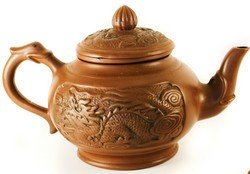
Generally speaking, there are two types of clay you have to be aware of: purple clay and red clay.
Purple clay is the most common and versatile type.
Because it is located at the bottom of the mine, it is also known as the "rock within the rock", or the "clay within the clay". High pressure causes it to acquire an iron-like solidity.
I highly recommend a purple for your first tea pot.
Red clay is also known as Hongni or Zhuni. It is found at the bottom of the mine, so it is very hard. Higher frequency, it is especially suitable for brewing an aromatic tea.
Red clay from the original Yixing mine is scarce, so only buy from a trustworthy source.
Yixing Teapot Types - Purple, Red (Zhuni, Hongni) and Green Clay
Tip #2:
How does it feel?
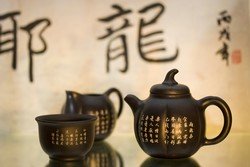
Getting a Chinese tea set is not just about brewing tea, it is also an intensely tactile experience.
If the tea pot comes from Yixing, it doesn't feel sticky. The clay is pleasant to touch. Although the surface appears grainy, the clay feels smooth.
If the tea pot is made from clay produced elsewhere, it feels sticky, a bit like touching glass.
If the tea pot has been mass-produced, the clay feels rough.
Yixing Clay (Zisha) - Purple Sand Secrets Explained
Tip #3:
How do you feel?
The third aspect relates to the style of the Chinese tea set. A Yixing tea pot is a brewing vessel, it is also a work of art.
The style it embodies captures the essence of the artist. Does the style speak to you in the same way? How do you feel about it?
If you feel connected, then it is the right vessel.
Tip #4:
Is it functional?
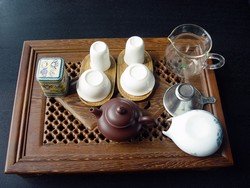
Here we are talking about craftsmanship and practicality.
Is the spout aligned to the handle? Are they balanced?
Does the lid fit snugly to the mouth? Would the lid fall inside the pot? Would the water spill when you are pouring?
Does water flow easily? Could the leaves get struck at the spout?
Capacity
Compared to Western pots, Yixing tea pots and cups are tiny. When brewing tea gongfu style, you steep leaves in boiling water for a short period of time, then quickly pour to 2 to 12 cups to drink.
(The tea cups are small, so the tea does cool quickly.)
If you are brewing for yourself, you may want to get a small pot - about 150 to 200 milliliters.
If you are brewing for you and your guests, you may want to get a larger pot - say 350 milliliters.
Remember, the amount of tea leaves increase with the size of the pot. If you are brewing a high quality tea for yourself, a smaller pot would do.
Tea Cups
For Yixing Chinese tea set, it is not important to have matching tea cups.
Many people use ceramic or ceramic coated tea cups. This is because the white color allow you to admire the color of the tea liquor more easily.
However, if having yixing tea cup is important to you, simply ask your tea shop. The quality of the clay is unlikely to be as high as the pot. So they tend to be available at much lower price.
Tea cups come in pairs, usually 2,4,6,8 and 12.
Shape
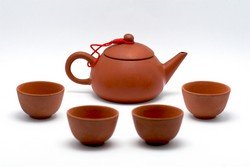
In general, I recommend you get a round-base tea pot of a suitable height.
Taller tea pot has smaller spout. They are suitable for black tea as they are more heat tolerant. But you have to make sure the water flows smoothly and tea does not over-steep.
Shorter tea pot has larger spout. They are suitable for green tea. But beware the water does not spill from the lid.
Tip #5:
What does it say?
A Chinese tea set is not just about the raw materials and craftsmanship. It is also about the culture contains within the calligraphy and seal.
What does the Chinese words say? Who is the engraver?
You can also find the potter's seal at the bottom of tea pot. Who is he? What's the design of the seal?
Yixing Pottery and Authenticity - Understanding Engraving and Seal
Tip #6:
Does it pass the test?
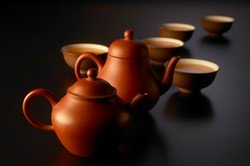
Touch the body of the tea pot. Does it feel solid and hard?
Look at the surface. Is it shiny?
Hit the lid against the tea pot body. Does it sound good? (High frequency should be used to brew aromatic oolongs, low frequency should be used to brew roasted oolongs.)
Smell it. If it smells earth, it is okay. If it smells burnt or oily or chemical, then something is not right.
Fill in water. Press the lid and spout against your fingers. Invert the pot. Can the pot hold the water without any leakage?
Fill in water. Invert the pot to drain. Does every single drop of water drain out?
Fill in water three-quarters full. Pour out slowly. Does you find it easy to pour?
Related Articles
Chinese Tea Pot and Set Review - Yixing and Gaiwan
Want to buy a Chinese tea pot and set? Tea was first cultivated in China, so no tea connoisseur should be without them.
New! Comments: Like This Story? Leave A Comment!
Back to Top of Chinese Tea Set
Back to Yixing Main Page
Back to Amazing Green Tea Home
Solving problems every tea drinker faces.
Exclusive subscriber benefits:
Receive four FREE quality ebooks worth $60
Save at least $5 during your first purchase
Copyright� 2006-2025 Amazing-Green-Tea.com. All rights reserved.

